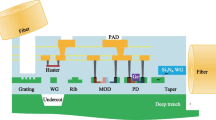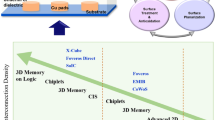Abstract
Multiwall carbon nanotube (MWCNT) has been investigated as a potential interconnect material for future advanced technology nodes. The present paper analyzes performance of MWCNT interconnects using current mode signaling (CMS) scheme. The novelty of the present work can be stated as: Firstly, a unified model is proposed for both copper and MWCNT interconnects using finite-difference time-domain (FDTD) technique. Secondly, this model is applicable for both the conventional voltage mode signaling and more versatile CMS schemes. Furthermore, the presented FDTD-based model is valid for single as well as M-line coupled interconnects in integrated circuits. The model also incorporates CMOS gate as driver for MWCNT interconnect. Thirdly, power model using FDTD technique is investigated for the first time. Accurate formulation and computation of power dissipation in CMS MWCNT interconnects are presented in the paper. Propagation delay, power dissipation and power_delay_product (PDP) are the performance metrics considered for single-line CMS MWCNT interconnect. Crosstalk is analyzed for 2-Line and 5-Line coupled interconnects. It is investigated that CMS scheme leads to about 4 times lesser propagation delay and 2.5 times reduced PDP in MWCNT interconnect than the conventional copper interconnect for interconnect length of 4500 \(\upmu \)m. The technology node considered is 32 nm. The response of the system is accurately computed using the proposed FDTD-based model. The maximum percentage error between results obtained by the proposed analytical model and SPICE simulation model is <3% for the various test cases.











Similar content being viewed by others
References
Y. Agrawal, R. Chandel, Crosstalk analysis of current-mode signalling-coupled RLC interconnects using FDTD technique. IETE Tech. Rev. 33(2), 148–159 (2016)
Y. Agrawal, R. Chandel, R. Dhiman, High performance current mode receiver design for on-chip VLSI interconnects, in Proceedings of the Springer International Conference on ICA. Series: Advances in Intelligent Systems and Computing, Durgapur, vol 343, Chapter 54 (2015), pp. 527–536
P. Avouris, Z. Chen, V. Perebeinos, Carbon-based electronics. Nat. Nanotechnol. 2(10), 605–613 (2007)
R. Bashirullah, W. Liu, R.K. Cavin, Current-mode signaling in deep submicrometer global interconnects. IEEE Trans. Very Large Scale Integr. Syst. 11(3), 406–417 (2003)
Q. Cao, J.A. Rogers, Ultrathin films of single-walled carbon nano-materials for electronics and sensors: a review of fundamental and applied aspects. Adv. Mater. 21(1), 29–53 (2009)
Carbon Nanotube Interconnect Analyzer (CNIA), https://nanohub.org/resources/cnia
R. Chandel, S. Sarkar, R.P. Agarwal, An analysis of interconnect delay minimization by low-voltage repeater insertion. Microelectron. J. 38(4–5), 649–655 (2007)
M. Chernobryvko, D. De Zutter, D.V. Ginste, Nonuniform multiconductor transmission line analysis by a two-step perturbation technique. IEEE Trans. Compon. Packag. Manuf. Technol. 4(1), 1838–1846 (2014)
M.H. Chowdhury, P. Khaled, J. Gjanci, An innovative power gating technique for leakage and ground bounce control in system-on-a-chip (SOC). Circuits Syst. Signal Process. 30(1), 89–105 (2011)
J.P. Cui, W.S. Zhao, W.Y. Yin, J. Hu, Signal transmission analysis of multilayer graphene nano-ribbon (MLGNR) interconnects. IEEE Trans. Electromagn. Compat. 54(1), 126–132 (2012)
D. Das, H. Rahaman, Analysis of crosstalk in single- and multiwall carbon nanotube interconnects and its impact on gate oxide reliability. IEEE Trans. Nanotechnol. 10(6), 1362–1370 (2011)
M. Dave, M. Jain, M.S. Baghini, D. Sharma, A variation tolerant current mode signaling scheme for on-chip interconnects. IEEE Trans. Very Large Scale Integr. Syst. 21(2), 342–353 (2013)
R. Dhiman, R. Chandel, Dynamic crosstalk analysis in coupled interconnects for ultra-low power applications. Circuits Syst. Signal Process. 34(1), 21–40 (2015)
M.K. Gowan, L.L. Biro, D.B. Jackson, Power considerations in the design of the Alpha 21264 microprocessor, in Proceedings IEEE Design Automation Conference, San Francisco (1998), pp. 726–731
International Technology Roadmap for Semiconductors (ITRS), http://public.itrs.net
A. Javey, J. Kong, Carbon Nanotube Electronics (Springer, Berlin, 2009)
W. Jin, H. Yoo, Y. Eo, Non-uniform multi-layer IC interconnect transmission line characterization for fast signal transient simulation of high-speed/high-density VLSI circuits. IEICE Trans. Electron. E82–C(6), 955–966 (1999)
S.M. Kang, Y. Leblebici, CMOS Digital Integrated Circuits (TMH, New Delhi, 2003)
V.R. Kumar, B.K. Kaushik, A. Patnaik, Crosstalk noise modeling of multiwall carbon nanotube (MWCNT) interconnects using finite-difference time-domain (FDTD) technique. Microelectron. Rel. 55(1), 155–163 (2015)
H. Li, K. Banerjee, Carbon nanomaterials for next-generation interconnects and passives: physics, status, and prospects. IEEE Trans. Electron Devices 56(9), 1799–1821 (2009)
H. Li, K. Banerjee, High-frequency analysis of carbon nanotube interconnects and implications for on-chip inductor design. IEEE Trans. Electron Devices 56(10), 2202–2214 (2009)
H. Li, W.Y. Yin, K. Banerjee, J.F. Mao, Circuit modeling and performance analysis of multi-walled carbon nanotube interconnects. IEEE Trans. Electron Devices 55(6), 1328–1337 (2008)
F. Liang, G. Wang, H. Lin, Modeling of crosstalk effects in multiwall carbon nanotube interconnects. IEEE Trans. Electromag. Compat. 54(1), 133–139 (2012)
M.K. Majumder, P.K. Das, B.K. Kaushik, Delay and crosstalk reliability issues in mixed MWCNT bundle interconnects. Microelectron. Rel. 54(11), 2570–2577 (2014)
A. Naeemi, J.D. Meindl, Performance modeling for single- and multiwall carbon nanotubes as signal and power interconnects in gigascale systems. IEEE Trans. Electron Devices 55(10), 2574–2582 (2008)
S.H. Nasiri, M.K.M. Farshi, R. Faez, Stability analysis in graphene nanoribbon interconnects. IEEE Electron Device Lett. 31(12), 1458–1460 (2010)
K.S. Novoselov et al., Electric field effect in atomically thin carbon films. Science 306(5696), 666–669 (2004)
J.Y. Park et al., Electron–phonon scattering in metallic single-walled carbon nanotubes. Nano Lett. 4(3), 517–520 (2004)
C.R. Paul, Incorporation of terminal constraints in the FDTD analysis of transmission lines. IEEE Trans. Electromag. Compat. 36(2), 85–91 (1994)
Predictive Technology Models (PTM), http://ptm.asu.edu
M. Sahoo, P. Ghosal, H. Rahaman, Performance modeling and analysis of carbon nanotube bundles for future VLSI circuit applications. J. Comput. Electron. 13(3), 673–688 (2014)
T. Sakurai, A.R. Newton, A simple MOSFET model for circuit analysis. IEEE Trans. Electron Devices 38(4), 887–894 (1991)
M.S. Sarto, A. Tamburrano, Single-conductor transmission line model of multiwall carbon nanotubes. IEEE Trans. Nanotechnol. 9(1), 82–92 (2010)
M. Tang, J.F. Mao, Transient analysis of lossy nonuniform transmission lines using a time-step integration method. Prog. Electromag. Res. 69, 257–266 (2007)
Tanner EDA tools, http://www.tannereda.com
M. Tiang, J. Mao, Modeling and fast simulation of multiwalled carbon nanotube interconnects. IEEE Trans. Electromag. Compat. 57(2), 232–240 (2015)
S. Tuuna, E. Nigussie, J. Isoaho, H. Tenhunen, Modeling of energy dissipation in RLC current-mode signaling. IEEE Trans. Very Large Scale Integr. Syst. 20(6), 1146–1151 (2012)
B.Q. Wei, R. Vajtai, P.M. Ajayan, Reliability and current carrying capacity of carbon nanotubes. Appl. Phys. Lett. 79(14), 3128–3131 (2001)
S.C. Wong, G.Y. Lee, D.J. Ma, Modeling of interconnect capacitance, delay and crosstalk in VLSI. IEEE Trans. Semicond. Manuf. 13(1), 108–111 (2000)
F. Yuan, CMOS Current Mode Circuits for Data Communication (Springer, Berlin, 2007)
Author information
Authors and Affiliations
Corresponding author
Appendices
Appendix 1
The parasitic elements of MWCNT interconnect can be defined as:
The lumped resistance (\(R_\mathrm{lump}\)) comprises of quantum resistance (\(R_\mathrm{q}\)) which is due to quantum confinement of carriers along the interconnect dimensions. The contact resistance (\(R_\mathrm{c}\)) is due to imperfect contact between the interconnect and substrate. \(R_\mathrm{c}\) depends on the fabrication process and varies from 1 to 20 K\(\Omega \) [10]. \(R_\mathrm{lump}\) is expressed as [19]
where h is Planck’s constant and e represents charge on electron.
\(R_\mathrm{lump}\) is distributed equally along the two ends of the interconnect as \(R_\mathrm{lump}^{\prime } \). It is presented as
The distributed resistance (\(R_\mathrm{dis}\)) in the ESC model represents the scattering resistance per unit length (p.u.l.) [22]. It is primarily due to optical and acoustic phonon scattering. \(R_\mathrm{dis}\) is predominant when interconnect length is greater than electron mean free path [28]. It is defined as [23]
where \(\lambda _{i}\) corresponds to effective electron mean free path of ith shell and is obtained as [24]
where \(T_{0}\)=100 K
The distributed inductance (\(L_\mathrm{dis}\)) comprises of kinetic inductance p.u.l. (\(L_\mathrm{k}\)) and magnetic inductance p.u.l. (\(L_\mathrm{m}\)).
The kinetic inductance p.u.l. per channel (\(L_\mathrm{k/channel}\)) is given as [19]
where \(v_\mathrm{f}\) is Fermi velocity.
Using \(L_\mathrm{k/channel}\), kinetic inductance p.u.l. per shell (\(L_\mathrm{k/shell}\)) is computed.
The p.u.l. mutual shell to shell inductance (\(L_\mathrm{m\_shell\_shell}\)) is defined as [23]
The equivalent kinetic inductance p.u.l. of ith shell (\(L_\mathrm{equ}^i\)) is obtained using recursive expression as [23]
where
The equivalent kinetic inductance p.u.l. of MWCNT interconnects (\(L_\mathrm{k}\)) is given by:
The equivalent magnetic inductance p.u.l. of MWCNT interconnect (\(L_\mathrm{m}\)) is computed as [24].
where \(d_{N}\) is the outermost shell diameter of MWCNT and \(h_\mathrm{g}\) represents the distance between MWCNT and ground plane.
The equivalent inductance in the ESC model (\(L_\mathrm{dis}\)) is computed as
Similarly, distributed capacitance (\(C_\mathrm{dis}\)) of MWCNT in the ESC model is obtained. It comprises of p.u.l. quantum capacitance (\(C_\mathrm{q}\)), and electrostatic capacitance (\(C_\mathrm{e}\)). \(C_\mathrm{dis}\) is expressed as
\(C_\mathrm{e}\) is obtained as [24]
\(C_\mathrm{q}\) is obtained by solving recursive formulae given below [23]
where \(C_\mathrm{equ}^i \)is the equivalent capacitance of ith shell. \(C_\mathrm{q/shell} \) and \(C_\mathrm{c\_shell\_shell}\) are p.u.l. quantum capacitance per shell and coupling capacitance between shells of MWNCT interconnect, respectively [11]. These are defined as [19]
The p.u.l. mutual inductance (\(M_\mathrm{i}\)) and coupling capacitance (\(C_\mathrm{c}\)) between two parallel MWCNT interconnects are given as [11, 21, 24, 31]
where l is the length of interconnect and \(s_{p}\) is the separation between two interconnects. \(h_\mathrm{c}\) is the center-to-center distance between two interconnects and equals to (\(s_{p}+d_{N}\)).
Appendix 2
The parasitic elements for copper interconnects can be defined as [30, 39]:
where \(\rho \) is resistivity of copper material. w and t are width and thickness of the copper interconnect. All other parameters for copper interconnects in (55)–(59) have their usual meaning as that for MWCNT interconnect. \(R_\mathrm{lump}^{\prime }\)in the ESC model for copper interconnect is zero.
Appendix 3
The Telegraph’s equations are given as [29]:
where [V] and [I] are \(M \times 1\) voltage and current variables along interconnect and are function of position and time. [R], [L] and [C] are \(M \times M\) dimensional p.u.l. interconnect parasitics. These are given as
where \(R_\mathrm{dis}\), \(L_\mathrm{dis}\) and \(C_\mathrm{dis}\) are distributed resistance, inductance and capacitance, respectively, of MWCNT/copper interconnect in ESC model. \(M_\mathrm{i}\) and \(C_\mathrm{c}\) represent p.u.l. mutual inductance and coupling capacitance between two parallel MWCNT/copper interconnects.
Rights and permissions
About this article
Cite this article
Agrawal, Y., Kumar, M.G. & Chandel, R. A Unified Delay, Power and Crosstalk Model for Current Mode Signaling Multiwall Carbon Nanotube Interconnects. Circuits Syst Signal Process 37, 1359–1382 (2018). https://doi.org/10.1007/s00034-017-0614-6
Received:
Revised:
Accepted:
Published:
Issue Date:
DOI: https://doi.org/10.1007/s00034-017-0614-6




